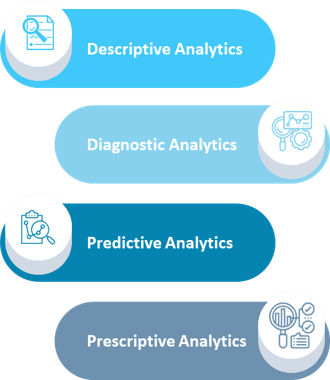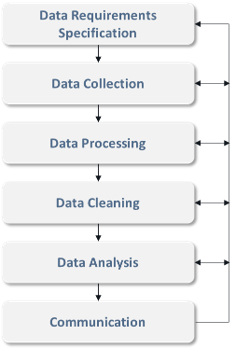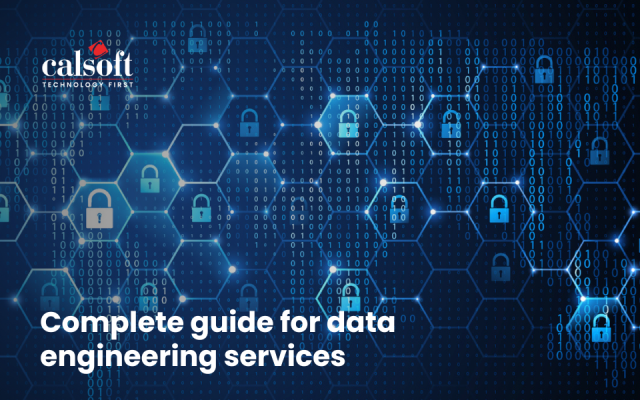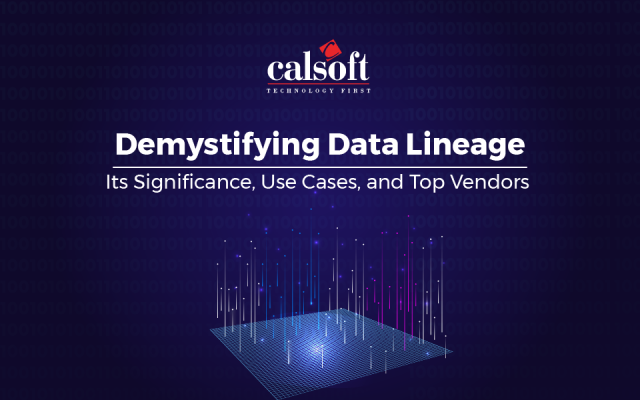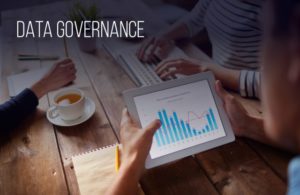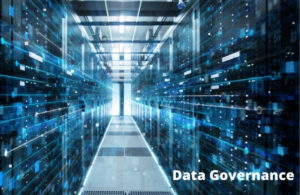Are you languishing to make sense of your firm’s data? Do you wish there was a way to ensure that your information is reliable and secure while extracting valuable insights? This is where amalgamating data governance and data analytics comes into play. You must devise a detailed strategy to use your data efficiently, ensure data quality security, and provide efficient management.
Data analytics is not just a catchline; it’s a swiftly evolving field that’s revamping industries. According to a report by Grand View Research, the global data analytics market size was valued at USD 49.03 billion in 2022 and is projected to grow at a compound annual growth rate (CAGR) of 26.7% from 2023 to 2030. This ferocious growth reinforces the augmenting dependence on data-driven decision-making in today’s business synopsis.
Moreover, the importance of data governance cannot be overstated. Efficient data governance ensures that data is precise, compatible, and attainable, which in turn improves the dependability of data analytics processes. A study by Forbes emphasizes that 83% of business leaders contemplate data to be a crucial component of their business strategy. Without powerful data governance, even the most sophisticated analytics tools can yield unreliable insights.
Let’s dive into the ultimate guide to data governance and data analytics and explore how you can revolutionize your data into a robust asset.
What is a Data Governance Framework?
Ever wondered how organisations handle their enormous amounts of data efficiently? Enter data governance, the backbone of successful data management strategies.
Data governance (DG) is an important process that ensures the availability, integrity, and security of data within an organization’s systems.
At its core, DG involves a set of processes, people, technology, roles, standards, and metrics. These elements work together to utilize data effectively in accomplishing organizational goals. By creating appropriate and clear processes and defined responsibilities, DG ensures high-quality and secure data usage.
According to Data Governance Institute (DGI), Data governance framework is a blueprint or defined structure that ensures your data is precise, attainable, and secure. It involves a set of practices and processes that manage and safeguard your data assets. By setting rules and liabilities, data governance helps you maintain high data quality and comply with regulations.
Why is Data Governance Framework Required?
Enterprises which handle massive amounts of data or big data, a robust DG strategy becomes very crucial.
A well-structured DG framework enables organisations to define policies and rules from the beginning, standardize significant data terms within the organization, document decision-making processes, share insights, identify data owners, distribute and assign roles and responsibilities, and build a robust roadmap tailored to the organization’s most critical use cases. The strategy determines crucial data that require stringent controls and predicts the advantages of these procedures.
The following image shows the reference end-to-end data governance framework.

Key Objective: The main purposes of data governance are maintaining data quality, security, and integrity. High data quality makes the data precise, congruous, and dependable, turning it into an asset for decision-making. Secure the data from illicit access and infringement with data security. Maintain unchangeable and steady data throughout its lifecycle with data integrity.
Roles Involved: In data governance, roles are vital. Data stewards act as the custodians of your data. They enforce data policies and maintain data quality. Meanwhile, the data governance committee manages the overall governance program. This panel includes stakeholders from distinct divisions who partner to define policies and resolve data-related problems.
Components: Policies, procedures, and standards are the components of data governance. Policies set the rules for data management and ensure everyone in your organization manages data continuously. Procedures outline the steps to follow these policies. Standards provide criteria for data quality and security, ensuring your data meets regulatory needs and internal anticipations.
By understanding and implementing data governance, you ensure your entity’s data becomes a powerful, reliable, and secure asset.
Now that we have a solid grasp of data governance, let’s explore what are the key steps to build a DG framework.
Building a Data Governance Framework
Let’s learn the necessary steps to ensure that the information is well-managed, secure, and affiliated with the organization goals.
Step 1: Assessing the Current State – Data Inventory and Gap Analysis
Commence with a clear picture of the current data scenario. Inventory all the data assets. Determine where the information resides, how to use it, and who has access to it. This initial assessment helps to comprehend the data’s strengths and weaknesses.
Next, execute a gap analysis. Contrast the current state to where you want to be. What’s missing? Are there areas where the data processes are lacking? This inspection will emphasize the gaps that are required to be acknowledged in the framework.
Step 2: Defining Goals and Objectives Aligned with Business Goals
The goals should affiliate with the overall organization’s purposes. If the organization intends to enhance customer contentment, the data goals might include better data precision and quicker access to customer data.
Set clear and definite purposes. For example, aim to reduce information errors by 20% within the next year. Clear goals give a torment to aim for and make it easier to gauge the success.
Step 3: Developing Roles, Responsibilities, and Security Protocols
Who will do what? Certainly, defining roles and liabilities is vital. Assign data supervision roles to individuals who govern data quality and compliance. Ensure everyone knows their part in maintaining data governance.
Pioneer security protocols to safeguard the information. Identify who can access explicit data sets under what circumstances. You should enforce data encryption and other security measures to protect sensitive data. Frequent training and updates on security conventions will keep everyone on the same page.
Step 4: Implementing and Monitoring the Framework
Now, it’s time to implement the strategy into action. Execute the processes and protocols established. This might involve setting up new software tools, creating documentation, and training your team.
Monitoring is key to ensuring your framework remains efficient. Frequently retrospect the information governance processes to determine areas for enhancement. Use metrics and feedback to gauge the progress toward the goals. Adapt the plans as required to keep the data governance framework in top shape.
Building a data governance framework might seem challenging. Still, by taking it step-by-step, can develop a system that aids the organizations’ goals and keeps the information protected and well-managed.
Now that we have a solid grasp of data governance, let’s turn our attention to the exciting world of data analytics.
Foundations of Data Analytics
The significance of Data analytics cannot be overemphasized. Enterprises, governments, and entities depend heavily on data-driven decisions to upgrade functioning, improve customer experiences, and stay fierce. But what precisely is Data analytics, and how it can revolutionize various organisations? Let’s know:
In the data-driven scenario, comprehending data analytics is vital. Data Analytics helps to extract applicable insights that can drive decision-making and improve the organization strategies. It’s all about turning raw information into valuable data. There are four types of analytics as shown in the image below:
- Descriptive Analytics: This type gives a response to the question, “What happened?” By encapsulating past information, helps to get a clear picture of factual trends and patterns.
- Diagnostic Analytics: This delve into “Why did it happen?” Diagnostic analytics helps to comprehend the causes behind the noticed trends and patterns.
- Predictive Analytics: Looking forward, predictive analytics asks, “What could happen?” By using statistical models and machine learning methods, helps to predict future events and trends.
- Prescriptive Analytics: Eventually, prescriptive analytics uses advanced algorithms and models to provide actionable recommendations based on forecasted results, helping to make optimal and informed decisions.
Data analysis process consists of the following phases that are reiterative in nature:
- Data Collection: You begin by collecting pertinent data from numerous sources. This can include repositories, surveys, social media, and more.
- Data Cleaning: Raw data often contains errors and inconsistencies. You clean the data to ensure precision and dependability, removing any irrelevant or incorrect data.
- Data Transformation: Once cleaned, information is transformed into a suitable format or inspection. This might involve standardizing information, accumulating it, or creating new variables.
- Data Modeling: In this step, you apply statistical and machine learning models to the revolutionized information. Modeling helps you determine patterns, relationships, and trends within the information.
- Data Visualization: Eventually, you present the detection through visualizations. Charts, graphs, and dashboards make it easier for you and others to comprehend and simplify the outcomes.
By following these steps and comprehending the types of analytics, you can use the power of data to drive meaningful insights and make well-informed decisions.
Also read the blog Data Driven Decision Process to explore how data-driven decision-making will be a transformative approach for industries.
Now, let’s explore the intersection of data governance and data analytics.
Intersection of Data Governance and Data Analytics
Continuing the deep dive into the ultimate guide to data governance and data analytics, let’s discover how these two vital elements intersect and drive success for various organisations.
Boosting Data Analytics with Data Governance
Data Governance offers the foundation for powerful data analytics. With efficient governance in place, you ensure that your data is precise, congruous, and dependable. Superior data is important because data analytics depends on it to produce meaningful insights. Without governance, you risk basing choices on defective or incomplete information, which can lead to erroneous strategies.
Data Quality Standards and Integration
One of the linchpins of data governance is endowing and maintaining data quality standards. By depicting what embodies high-quality information, you set criteria for precision, entirety, and consistency. When these standards are in place, incorporating information from numerous sources becomes a sleek process. Your analytics tools can then operate with unified datasets, making it easier to reveal trends, patterns, and applicable insights.
Ensuring Data Lineage and Transparency
Comprehending data lineage is critical for efficient analytics. Data governance helps you track the origins, movements, and conversions of your information across its longevity. This lucidity ensures that you can trust your information and comprehend the context behind the numbers. When you know where your information comes from and how it has been refined, you can expectantly simplify your analytics outcomes and make informed decisions.
Facilitating Effective Data Management
Efficient data management is all about arranging and maintaining your information in a way that’s easy to discover and use. This means setting up systems and processes that permit you to store, access, and dissect your data effectively, saving you time and resources.
Ensuring Regulatory Compliance in Analytics
In today’s regulatory environment, compliance is non-negotiable. Data governance plays a crucial role in ensuring that your data practices affiliate with pertinent laws and regulations. This is specifically significant in data analytics, where the embezzling of information can lead to substantial legitimate consequences. Compliance standards help safeguard your entity from fines and penalties and build trust with your investors.
Data governance and data analytics are extremely interconnected. Efficient data governance improves the quality and dependability of your analytics, ensures smooth data incorporation, maintains lucidity through data lineage, and advocates regulatory compliance. Investing in both sets the stage for data-driven success and a contending edge in your industry.
By concentrating on these objectives, you can use the full power of data governance in your data analytics efforts, leading to more precise insights and better venture decisions.
Let’s take a closer look at the practical steps for implementing data governance within your analytics framework.
Practical Implementation of Data Governance in Analytics
Enforcing data governance in analytics is a challenging task, however it is important for making the most out of the information.

Let’s break down the key steps in an applicable and direct way:
| Key Steps | Description |
| Setting Guidelines for Data Usage Consistency
|
|
| Reducing the Risk of Flawed Decision-Making
|
|
| Enhancing Cross-Department Collaboration
|
|
By following these steps, you can efficiently enforce data governance in your analytics, ensuring precision, compliance, and improved partnership.
Parting Thoughts
Integrating data governance with data analytics is necessary for any entity looking to use its data efficiently. By ensuring data quality, security, and integrity, you can extract valuable insights and make informed decisions that drive enterprise success. A planned approach to data governance and analytics not only improves decision-making but also helps accomplish the organizational goals.
Calsoft’s Data Governance practice offers well designed governance services that empower customers to keep data in an organized, accurate, compliant, and secure with the predominant regulatory norms at any stage.

